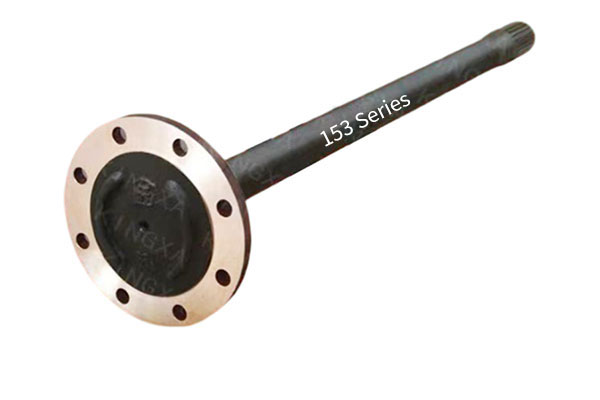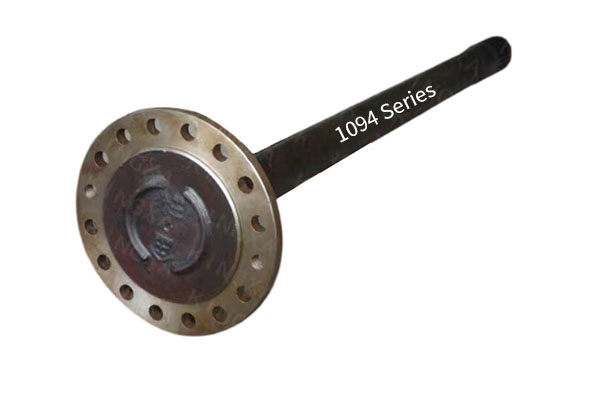Frequent start-stop conditions, how does the heavy-duty vehicle rear axle half shaft cope with fatigue challenges?
Release Time : 2025-04-03
In the field of modern transportation, heavy-duty vehicles play a vital role, and they undertake a large number of cargo transportation tasks. However, under the frequent start-stop urban conditions, the heavy-duty vehicle rear axle half shaft faces severe fatigue challenges.
1. Wisdom of material selection
Material is the basis of the fatigue strength of the rear axle half shaft. Under frequent start-stop conditions, the rear axle half shaft needs to withstand huge torsional and bending forces. Therefore, it is crucial to select high-strength and high-toughness materials. At present, the common rear axle half shaft materials on the market include carbon steel, alloy steel and high-strength cast iron. Among them, high-strength alloy steels such as 40Cr have become the first choice of many heavy-duty vehicle manufacturers due to their good comprehensive mechanical properties and heat treatment effects. These materials not only have high yield strength and tensile strength, but also can obtain good surface hardness and core toughness during heat treatment, thereby improving the fatigue life of the half shaft.
2. Optimization of structural design
Structural design is equally important for improving the fatigue strength of the rear axle half shaft. Under frequent start-stop conditions, the stress concentration points of the half shaft are often prone to become the initiation sites of fatigue cracks. Therefore, in the structural design, the appearance of stress concentration points such as steps and fillets should be avoided as much as possible. At the same time, through reasonable transition arc and fillet design, the stress concentration degree can be reduced and the fatigue strength of the half shaft can be improved. In addition, increasing the cross-sectional size of the half shaft and adopting hollow structure and other design methods can also effectively improve the bearing capacity of the half shaft.
3. Innovation of manufacturing process
The manufacturing process has a vital influence on the fatigue life of the rear axle half shaft. During the manufacturing process, the quality of raw materials should be strictly controlled to ensure that the chemical composition and mechanical properties of the materials meet the design requirements. At the same time, the use of advanced forging, rolling and other hot processing processes can refine the grains, improve the density and uniformity of the materials, thereby reducing the probability of fatigue crack initiation. In addition, surface treatment technologies such as shot peening, carburizing and quenching can also effectively improve the surface hardness and fatigue strength of the half shaft.
4. The importance of maintenance
Maintenance is a key link in extending the service life of the rear axle half shaft. Under frequent start-stop conditions, the rear axle half shaft is susceptible to wear and corrosion, which reduces its fatigue strength. Therefore, it is necessary to regularly inspect and replace severely worn half shaft parts. At the same time, keeping the half shaft clean and lubricated can also effectively reduce the rate of wear and corrosion. In addition, for half shafts with cracks or deformation, they should be repaired or replaced in time to avoid traffic accidents caused by half shaft failure.
5. Intelligent monitoring and early warning
With the development of science and technology, intelligent monitoring and early warning systems have become an important means to improve the safety of heavy-duty vehicles. By installing sensors and monitoring systems on the rear axle half shaft, the stress state, temperature changes and other information of the half shaft can be monitored in real time, and potential fatigue cracks and abnormal conditions can be detected in time. Once an abnormal condition is detected, the system can automatically issue an early warning signal to remind the driver or maintenance personnel to take appropriate measures to deal with it. This intelligent monitoring and early warning system can not only improve the safety of heavy-duty vehicles, but also reduce the economic losses caused by half shaft failure.
In summary, under frequent start-stop conditions, heavy-duty vehicle rear axle half shaft faces severe fatigue challenges. The fatigue strength and service life of the half-axle can be effectively improved through reasonable material selection, structural optimization design, manufacturing process innovation and maintenance measures. At the same time, with the widespread application of intelligent monitoring and early warning systems, the safety of heavy-duty vehicles will also be further improved.
1. Wisdom of material selection
Material is the basis of the fatigue strength of the rear axle half shaft. Under frequent start-stop conditions, the rear axle half shaft needs to withstand huge torsional and bending forces. Therefore, it is crucial to select high-strength and high-toughness materials. At present, the common rear axle half shaft materials on the market include carbon steel, alloy steel and high-strength cast iron. Among them, high-strength alloy steels such as 40Cr have become the first choice of many heavy-duty vehicle manufacturers due to their good comprehensive mechanical properties and heat treatment effects. These materials not only have high yield strength and tensile strength, but also can obtain good surface hardness and core toughness during heat treatment, thereby improving the fatigue life of the half shaft.
2. Optimization of structural design
Structural design is equally important for improving the fatigue strength of the rear axle half shaft. Under frequent start-stop conditions, the stress concentration points of the half shaft are often prone to become the initiation sites of fatigue cracks. Therefore, in the structural design, the appearance of stress concentration points such as steps and fillets should be avoided as much as possible. At the same time, through reasonable transition arc and fillet design, the stress concentration degree can be reduced and the fatigue strength of the half shaft can be improved. In addition, increasing the cross-sectional size of the half shaft and adopting hollow structure and other design methods can also effectively improve the bearing capacity of the half shaft.
3. Innovation of manufacturing process
The manufacturing process has a vital influence on the fatigue life of the rear axle half shaft. During the manufacturing process, the quality of raw materials should be strictly controlled to ensure that the chemical composition and mechanical properties of the materials meet the design requirements. At the same time, the use of advanced forging, rolling and other hot processing processes can refine the grains, improve the density and uniformity of the materials, thereby reducing the probability of fatigue crack initiation. In addition, surface treatment technologies such as shot peening, carburizing and quenching can also effectively improve the surface hardness and fatigue strength of the half shaft.
4. The importance of maintenance
Maintenance is a key link in extending the service life of the rear axle half shaft. Under frequent start-stop conditions, the rear axle half shaft is susceptible to wear and corrosion, which reduces its fatigue strength. Therefore, it is necessary to regularly inspect and replace severely worn half shaft parts. At the same time, keeping the half shaft clean and lubricated can also effectively reduce the rate of wear and corrosion. In addition, for half shafts with cracks or deformation, they should be repaired or replaced in time to avoid traffic accidents caused by half shaft failure.
5. Intelligent monitoring and early warning
With the development of science and technology, intelligent monitoring and early warning systems have become an important means to improve the safety of heavy-duty vehicles. By installing sensors and monitoring systems on the rear axle half shaft, the stress state, temperature changes and other information of the half shaft can be monitored in real time, and potential fatigue cracks and abnormal conditions can be detected in time. Once an abnormal condition is detected, the system can automatically issue an early warning signal to remind the driver or maintenance personnel to take appropriate measures to deal with it. This intelligent monitoring and early warning system can not only improve the safety of heavy-duty vehicles, but also reduce the economic losses caused by half shaft failure.
In summary, under frequent start-stop conditions, heavy-duty vehicle rear axle half shaft faces severe fatigue challenges. The fatigue strength and service life of the half-axle can be effectively improved through reasonable material selection, structural optimization design, manufacturing process innovation and maintenance measures. At the same time, with the widespread application of intelligent monitoring and early warning systems, the safety of heavy-duty vehicles will also be further improved.







